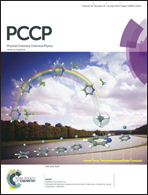Sorting particles with nanoscale thermophoretic devices: how efficient is it?
Abstract
We investigate particle separation driven by thermal gradients across solid state nanopores using a combined molecular dynamics simulation, non-equilibrium thermodynamics theory and a kinetic model approach. The thermophoretic device, a thermal nanopump, exploits thermal gradients to sort particles of different mass, which accumulate preferentially in hot or cold reservoirs. We show that the large amount of energy dissipated by the thermal nanopump during the transport process leads in general to very low efficiencies, 0.01–0.15%. We find that the nanopump thermal conductivity and structure plays a crucial role in determining the efficiency and a route to enhance it. Doubling the pore radius, from 0.5–1 nm radius, leads to a large increase in the mass diffusion and to a 20 fold increase in the efficiency. Addition of nanoscale defects, without modification of the nanopore structure, leads to a large reduction of the nanopump thermal conductivity and to a large enhancement of the thermodynamic efficiency. We find that nanopumps with nanoscale defects are >3 times more efficient than those without defects. Finally, we identify the microscopic variables responsible for the enhancement of thermally induced transport across nanopores and discuss strategies to tune these variable in order to regulate transport efficiency.


 Please wait while we load your content...
Please wait while we load your content...